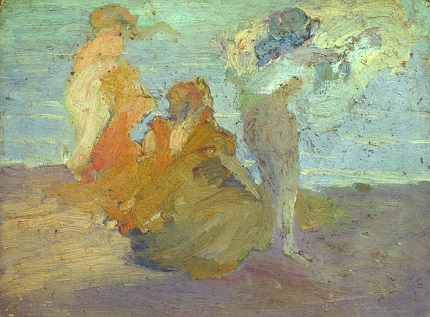
| Print | Back |  |
August 18, 2014 |
 |
Moments in Art "Shadow and Sunshine"by Lawrence Jeppson |
I can’t illustrate this column, for reasons that soon will become evident. I’d like to, but I don’t enjoy making my editors grimace.
Well, maybe I can find something appropriate that I can sneak in.
I began researching and writing the biography of William Henry Clapp about forty years ago. I benefitted from research that Gyöngy (Ginger) Laky had done for her father, Les Laky of Laky Gallery in Carmel, California. Les had acquired the Clapp estate from Donn Schroder, one of Clapp’s three stepsons.
Among Laky’s wealthy clients who frequented the Carmel-Monterey area was the late Richard Mellon Scaife. From time to time Scaife left Laky Gallery with his latest Clapp acquisition. He described his Clapps to Laky as “jewels hung on my walls, along with my Renoirs and Monets.”
Clapp preferred painting on thin wood panels, artist’s board, and Masonite, most frequently in 15 x 18" format. These were easy to carry into the field for plein aire painting. The executors of Clapp’s estate protected each remaining painting with paper interleaves and then packaged them in groups of ten of a size.
Laky said to me, “You can open any of these packs at random, and you will find nothing but fine paintings in each package.”
My research was impeded by my residence in Bethesda, Maryland, a long distance from the necessary California resources. I did manage to get interviews in Oakland with Louis Siegriest, the last survivor of the Society of Six, and Donn Schroder, the Clapp stepson who sold the estate to Laky. After moving to Utah, I would have Oakland interviews in person and by email with Jack Schroder, 92, Donn’s estranged twin.
Unfortunately, I encountered significant hostility from California museum officials who did not want me doing this. (I will not elaborate.) Consequently, there were long periods when my work on my book The Joy of Vision! lay fallow.
I wrote a provisional 20,000-word biography, William Henry Clapp, the Gentle Impressionist, and made copies available to Joan Murray, who was curating a traveling museum exhibition of Canadian Impressionism; Nancy Boas, who was writing her brilliant book The Society of Six; and Carol Lowrey, who was curating Visions of Light and Air, another circulating museum collection of Canadian Impressionism.
I should explain that Clapp was born of American parents in Montreal. He went to school in Oakland, California, then went back for four years of art school in Montreal.
He spent nearly four years in Paris studying art before returning to Montreal to exhibit and win the first Dow prize, which selected the best painting of the year by a Canadian. During WWI he abandoned Canada to spend two years painting on the Isle of Pines, Cuba. He moved back to Oakland, where he headed the Oakland Museum for 34 years and became the luminary of the fabled Society of Six artists.
Thus he is claimed by both Canada and America.
The Gentle Impressionist left too many unanswered questions. After moving to Utah, I decided I needed to finish the biography and study of William Henry Clapp, his art, and his times. I still face some unanswered questions, but one cannot put off doing an important task while waiting for perfection. Yet I realize that what I write may stand for a long time as the definitive study of this dedicated and gifted man.
This has presented me with a difficult decision. Trained in the best art academies in Montreal and Paris, Clapp liked to paint the human female figure. In fact, he taught life painting in Montreal and Oakland.
Once in Montreal when he was ill, his friend A. Y. Jackson stepped in to substitute teach for him. The irony of this is that in his entire career, Jackson, who would become one of Canada’s most-loved artists, painted only one picture that had a woman in it. She was clothed.
Clapp was the only member of the Six who excelled in painting nudes. You can look through the Joan Murray, Nancy Boas, and Carol Lowrey books and you will not find any nudes, not by Clapp, not by anyone.
Originally, I intended The Joy of Vision! to be only about Clapp’s landscapes. But I have come to realize that ignoring Clapp’s figure pieces would leave the reader with a partial picture of this painter.
I have acquaintances who do not approve of nude depictions, ignoring a tradition that goes back to the Greeks and is manifest in some of the greatest works of Western art, paintings and sculptures by da Vinci, Michelangelo, Rembrandt, Goya, Manet, Renoir. They somehow equate nudity with pornography. I disagree.
I am on the home stretch of finishing The Joy of Vision!. I have decided to include a separate chapter, “Shadow and Sunshine.” I am sorry if that part offends anyone. I do not apologize.
To understand the meaning of “Shadow and Sunshine,” when the book comes out you’ll need to read the chapter.

| Copyright © 2024 by Lawrence Jeppson | Printed from NauvooTimes.com |